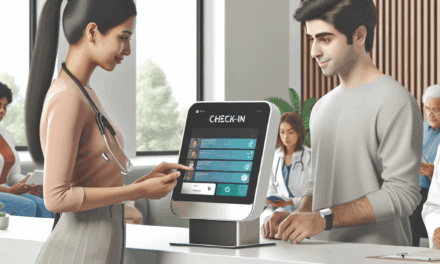Effective Strategies for Integrating Healthcare Translation Services in Clinical Environments
In an increasingly multicultural society, healthcare providers face the challenge of delivering effective care to patients who speak different languages. The integration of healthcare translation services is essential for ensuring that all patients receive equitable treatment and understand their medical conditions and treatment options. This article explores effective strategies for integrating healthcare translation services in clinical environments, focusing on five key areas: understanding the need for translation services, selecting the right translation methods, training healthcare staff, implementing technology solutions, and evaluating the effectiveness of translation services.
Understanding the Need for Translation Services
The first step in integrating healthcare translation services is recognizing the necessity of these services in clinical settings. Language barriers can lead to miscommunication, which can adversely affect patient outcomes. According to the U.S. Department of Health and Human Services, individuals with limited English proficiency (LEP) are at a higher risk of experiencing adverse health outcomes due to misunderstandings in medical instructions, medication dosages, and treatment plans.
Statistics reveal that approximately 25 million people in the United States speak English less than “very well,” highlighting the significant population that may require translation services. The need for these services is not limited to verbal communication; written materials such as consent forms, discharge instructions, and educational pamphlets must also be accessible in multiple languages.
Moreover, the legal implications of failing to provide adequate translation services cannot be overlooked. Healthcare providers are required by law to offer language assistance services under Title VI of the Civil Rights Act of 1964. Non-compliance can lead to lawsuits and financial penalties, further emphasizing the importance of integrating effective translation services.
Selecting the Right Translation Methods
Once the need for translation services is established, the next step is to select the appropriate methods for delivering these services. There are several options available, each with its advantages and disadvantages:
- In-Person Interpreters: These professionals provide real-time translation during patient interactions. They are particularly useful in complex medical situations where nuanced understanding is crucial. However, they may not always be available, and their services can be costly.
- Telephone Interpreting: This method allows healthcare providers to connect with interpreters via phone. It is a cost-effective solution that can be used in emergencies or when in-person interpreters are unavailable. However, it may lack the personal touch of face-to-face communication.
- Video Remote Interpreting (VRI): VRI combines the benefits of in-person and telephone interpreting by providing visual communication through video technology. This method is particularly effective for sign language interpretation and can enhance understanding through visual cues.
- Written Translation: Important documents such as consent forms, patient education materials, and discharge instructions should be translated into the languages spoken by the patient population. This ensures that patients have access to critical information in a language they understand.
- Machine Translation: While not a substitute for human interpreters, machine translation tools can assist in translating simple phrases or documents. However, they may not always provide accurate translations, especially in medical contexts.
Healthcare organizations must assess their patient demographics to determine which methods will be most effective. For instance, a facility serving a large Hispanic population may prioritize Spanish-language materials and interpreters, while a clinic in a diverse urban area may need to accommodate multiple languages.
Training Healthcare Staff
Integrating translation services into clinical environments requires more than just hiring interpreters or purchasing translation software; it also necessitates training healthcare staff on how to effectively utilize these services. Staff training should encompass several key areas:
- Understanding Cultural Competence: Healthcare providers must be aware of cultural differences that may affect patient interactions. Training should include information on cultural beliefs, practices, and values that influence health behaviors and perceptions.
- Effective Communication Techniques: Staff should be trained on how to communicate effectively with patients who have limited English proficiency. This includes speaking slowly, using simple language, and avoiding medical jargon.
- Utilizing Translation Services: Healthcare staff should be familiar with the available translation services and how to access them. This includes knowing when to call an interpreter, how to use VRI, and how to provide translated written materials.
- Recognizing the Importance of Patient Engagement: Training should emphasize the importance of engaging patients in their care. This includes encouraging patients to ask questions and ensuring they understand their treatment plans.
- Addressing Bias and Stereotypes: Staff should be trained to recognize and address their own biases and stereotypes that may affect their interactions with patients from diverse backgrounds.
By investing in comprehensive training programs, healthcare organizations can foster a culture of inclusivity and improve patient-provider communication, ultimately leading to better health outcomes.
Implementing Technology Solutions
Technology plays a crucial role in enhancing healthcare translation services. The integration of technology can streamline communication processes and improve access to translation services. Here are some effective technology solutions:
- Telehealth Platforms: Many telehealth platforms now offer built-in translation services, allowing providers to communicate with patients in real-time, regardless of language barriers. This is particularly beneficial for remote consultations and follow-up appointments.
- Mobile Apps: There are various mobile applications designed specifically for healthcare translation. These apps can provide instant translations of medical terms and phrases, making it easier for providers to communicate with patients on the go.
- Electronic Health Records (EHR): EHR systems can be programmed to include language preferences for patients, ensuring that all communication and documentation are tailored to the patient’s language needs. This can enhance the overall patient experience and reduce the risk of miscommunication.
- Artificial Intelligence (AI): AI-powered translation tools are becoming increasingly sophisticated and can assist in translating medical documents and patient communications. While they should not replace human interpreters, they can serve as a valuable resource for healthcare providers.
- Online Training Modules: Technology can also facilitate staff training through online modules that cover cultural competence, effective communication, and the use of translation services. This allows for flexible training schedules and can reach a larger audience.
By leveraging technology, healthcare organizations can enhance their translation services, making them more accessible and efficient for both providers and patients.
Evaluating the Effectiveness of Translation Services
The final step in integrating healthcare translation services is to evaluate their effectiveness continually. This involves assessing both the quality of the translation services and their impact on patient outcomes. Here are some strategies for evaluation:
- Patient Feedback: Collecting feedback from patients who have utilized translation services can provide valuable insights into their experiences. Surveys and focus groups can help identify areas for improvement and highlight successful practices.
- Monitoring Health Outcomes: Healthcare organizations should track health outcomes for patients who use translation services compared to those who do not. This can help determine whether translation services are effectively reducing disparities in care.
- Quality Assurance Programs: Implementing quality assurance programs can help ensure that translation services meet established standards. This may include regular audits of interpreter performance and the accuracy of translated materials.
- Staff Training Evaluations: Assessing the effectiveness of staff training programs can help identify gaps in knowledge and areas for improvement. Regular evaluations can ensure that staff remain competent in utilizing translation services.
- Benchmarking Against Best Practices: Healthcare organizations can compare their translation services to those of other institutions to identify best practices and areas for improvement. This can foster a culture of continuous improvement.
By regularly evaluating translation services, healthcare organizations can ensure that they are meeting the needs of their diverse patient populations and providing high-quality care.
Conclusion
Integrating healthcare translation services in clinical environments is essential for providing equitable care to diverse patient populations. By understanding the need for these services, selecting the right translation methods, training healthcare staff, implementing technology solutions, and evaluating effectiveness, healthcare organizations can enhance communication and improve patient outcomes.
The integration of translation services not only complies with legal requirements but also fosters a culture of inclusivity and respect for diverse backgrounds. As healthcare continues to evolve, the importance of effective communication will only grow, making the integration of healthcare translation services a critical component of patient-centered care.
In summary, the strategies outlined in this article provide a comprehensive framework for healthcare organizations looking to improve their translation services. By prioritizing these efforts, providers can ensure that all patients receive the care they deserve, regardless of language barriers.





